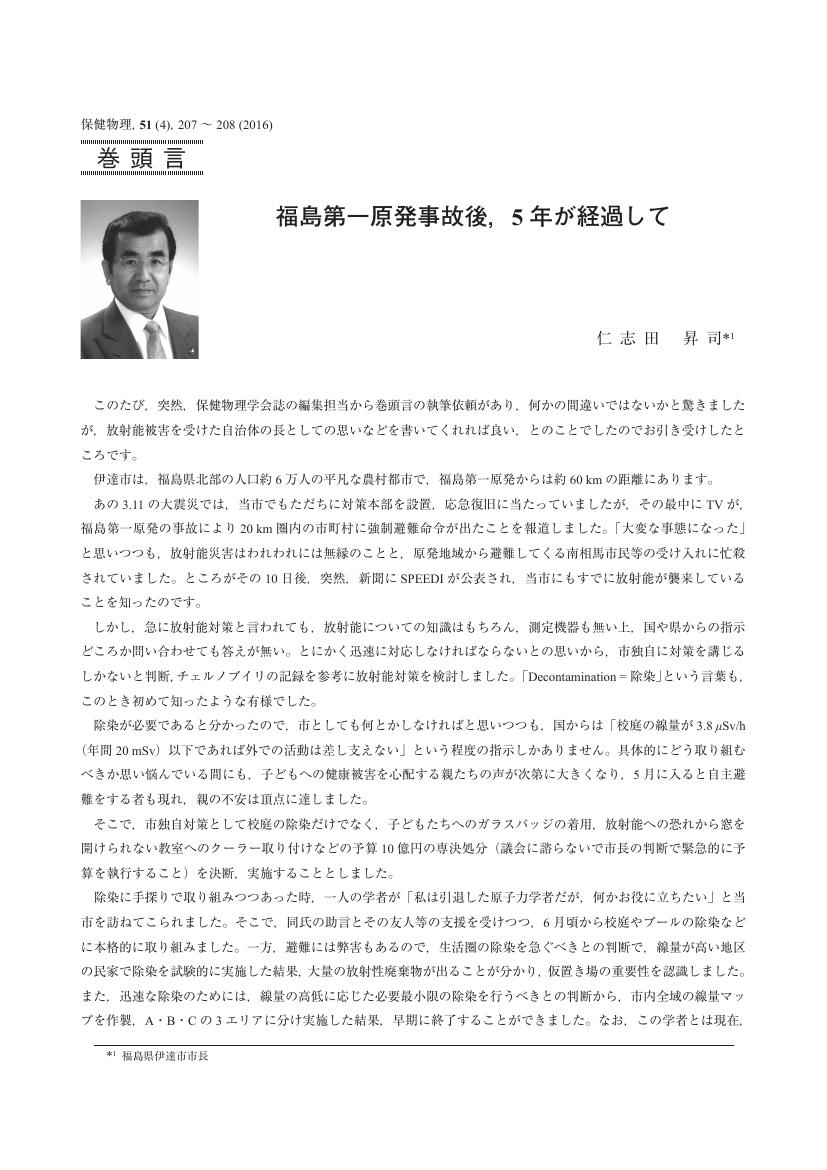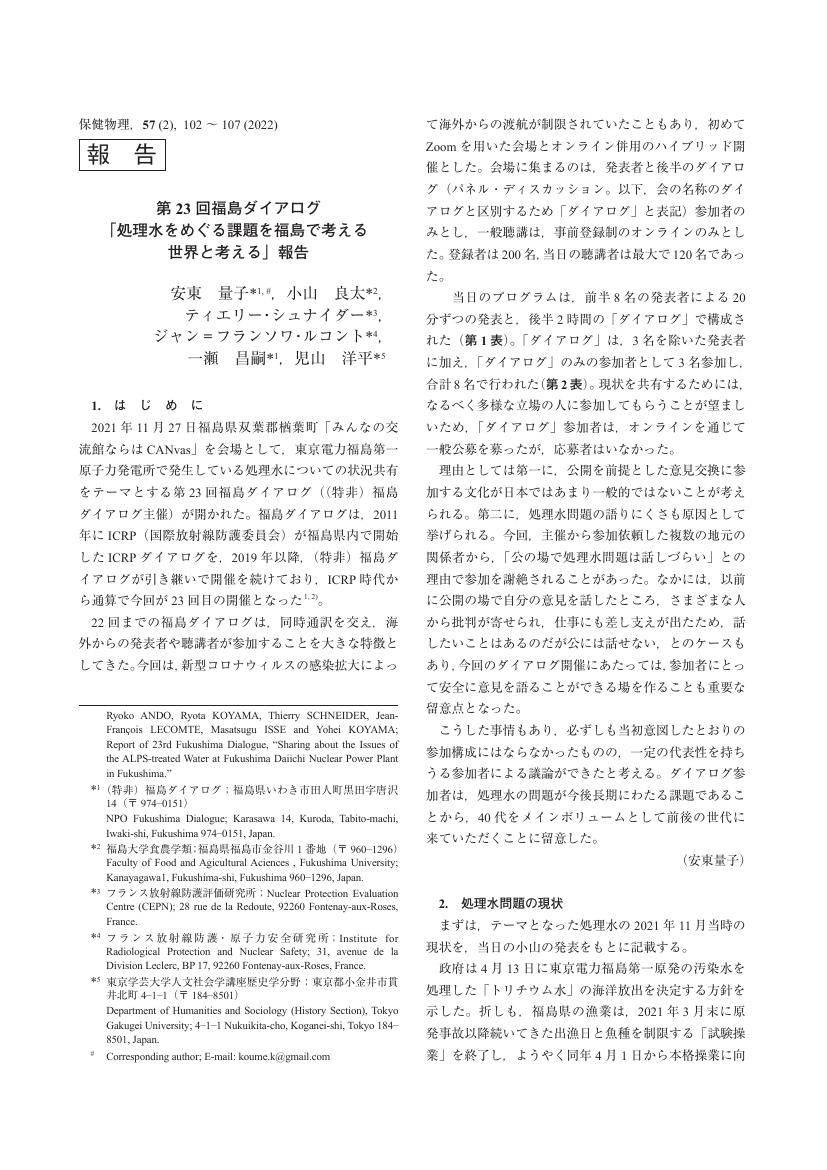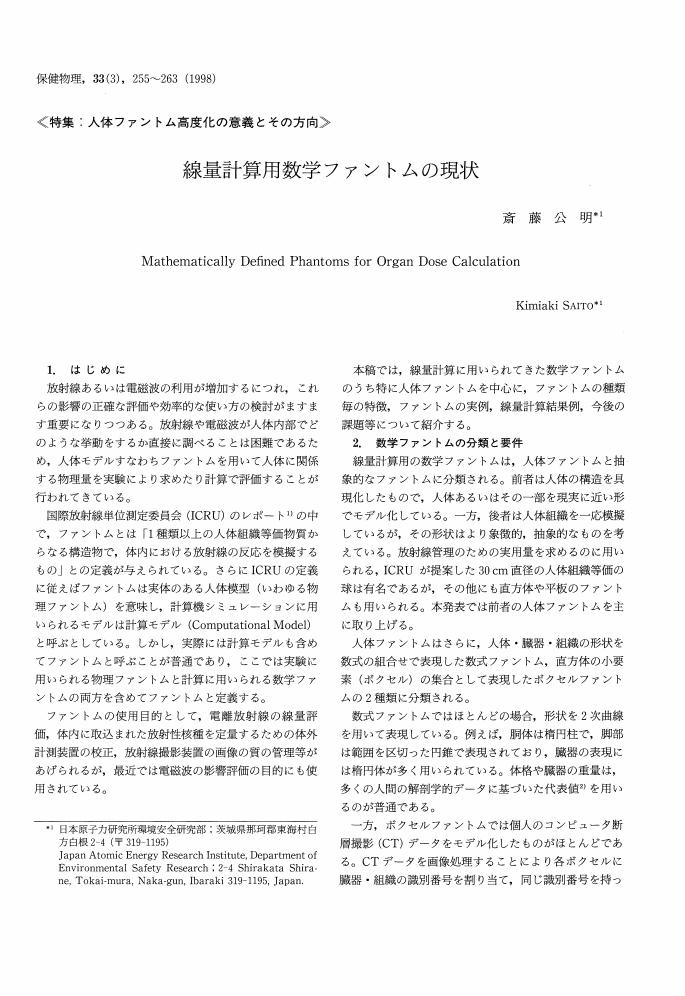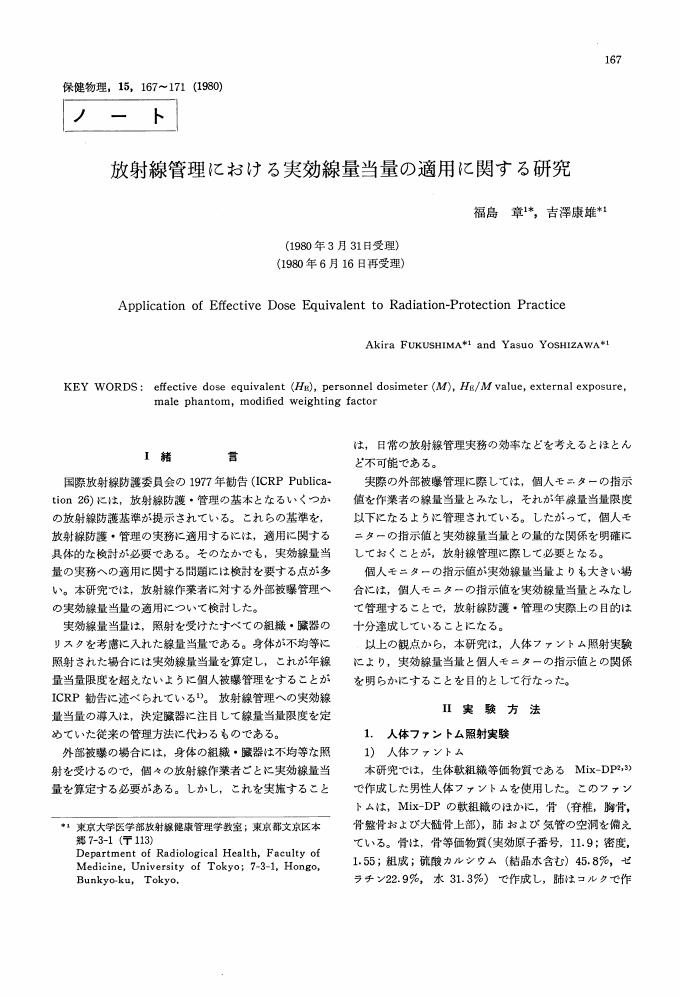10 0 0 0 OA 福島原発事故の経験と将来への提言:事故から7年を振り返って
10 0 0 0 OA 自然放射線における空気吸収線量から実効線量当量への換算係数の評価
- 著者
- 森内 茂 堤 正博 斎藤 公明
- 出版者
- Japan Health Physics Society
- 雑誌
- 保健物理 (ISSN:03676110)
- 巻号頁・発行日
- vol.25, no.2, pp.121-128, 1990 (Released:2010-02-25)
- 参考文献数
- 13
- 被引用文献数
- 21 26
A practical conversion factor to estimate the value of effective dose equivalent rate in Sv unit from absorbed dose rate in air in Gy unit was examined for natural gamma radiations. The experimental examination was carried out by two methods; one measures the effective dose equivalent rate directly by using a measuring instrument having effective dose equivalent response for isotropic gamma radiations and the other obtaines it from calculation applying the gamma flux-to-effective dose equivalent factor to actual gamma energy spectrum measured in various indoor and outdoor places.From these investigations the value of the quotient of effective dose equivalent to absorbed dose in air was found do be 0.748±0.007 Sv per Gy for natural radiation exposures in various environments. The value of the quotient 0.7, which is adopted to applied to environmental gamma radiations in the UNSCEAR 1982 and 1988 Reports, was clarified to be about 7% lower than the one obtained experimentally for natural gamma radiations.
10 0 0 0 OA 福島第一原子力発電所事故後の大気中放射性物質濃度測定結果に基づく線量の評価
- 著者
- 竹安 正則 住谷 秀一 古田 定昭
- 出版者
- 日本保健物理学会
- 雑誌
- 保健物理 (ISSN:03676110)
- 巻号頁・発行日
- vol.48, no.3, pp.141-149, 2013 (Released:2013-12-10)
- 参考文献数
- 13
- 被引用文献数
- 1
On the basis of the measurement results of airborne radionuclide concentrations in the Nuclear Fuel Cycle Engineering Laboratories, Japan Atomic Energy Agency, the committed effective dose to adults and the committed equivalent dose to thyroid of infants by inhalation were estimated for various indoor and outdoor exposure scenarios. It was demonstrated that the indoor to outdoor airborne radionuclide concentration ratio had a dominant effect on the dose estimate. The committed effective dose to adults was estimated to 0.098 mSv, and the committed equivalent dose to thyroid of infants was 1.8 mSv. These doses were about 1/6 and about 1/9, respectively, compared to the provisional ones with such assumptions as continuous outdoor stay.
10 0 0 0 OA 安定ヨウ素剤投与に関する基準
10 0 0 0 OA クラーク論文に対する私見
- 著者
- 草間 朋子
- 出版者
- 日本保健物理学会
- 雑誌
- 保健物理 (ISSN:03676110)
- 巻号頁・発行日
- vol.35, no.1, pp.91-93, 2000 (Released:2010-02-25)
- 被引用文献数
- 1
10 0 0 0 OA 新潟県中越沖地震被災地における環境放射線モニタリング
- 著者
- 山崎 興樹
- 出版者
- 日本保健物理学会
- 雑誌
- 保健物理 : hoken buturi (ISSN:03676110)
- 巻号頁・発行日
- vol.43, no.2, pp.112-121, 2008-06
9 0 0 0 OA 放射性ヨウ素の摂取に関する日本人の内部被曝線量換算係数の試算
- 著者
- 外川 織彦
- 出版者
- 日本保健物理学会
- 雑誌
- 保健物理 (ISSN:03676110)
- 巻号頁・発行日
- vol.27, no.1, pp.27-32, 1992 (Released:2010-02-25)
- 参考文献数
- 17
- 被引用文献数
- 1
Internal dose coefficients for ingestion and inhalation of radioiodine were preliminarily calculated considering the metabolic characteristics of Japanese. In the calculation, the fractional uptake by thyroid (f) of iodine entering blood and biological half-life in thyroid (Tb) were reflected among the data peculiar to Japanese concerning thyroid structure and iodine metabolism in thyroid. A metabolic model for iodine used here was based on the three-compartment recycle model described in the ICRP Publication 30. As to the parameters of f and Tb, the values of 0.2 and 40 days reported for Japanese were used instead of those of 0.3 and 80 days adopted by ICRP.The dose coefficients for Japanese calculated here are smaller than those for Reference Man of Caucasian. The author expects that the coefficients will be used for radiation protection purpose for workers and adults of the public in Japan.
9 0 0 0 OA 福島第一原発事故後, 5年が経過して
- 著者
- 仁志田 昇司
- 出版者
- 日本保健物理学会
- 雑誌
- 保健物理 (ISSN:03676110)
- 巻号頁・発行日
- vol.51, no.4, pp.207-208, 2016 (Released:2017-02-02)
- 被引用文献数
- 1
9 0 0 0 OA 福島周辺の家屋の内外におけるγ線スペクトルの評価
- 著者
- 谷村 嘉彦 富田 純平 吉富 寛 吉澤 道夫 箱崎 亮三 高橋 荘平
- 出版者
- 日本保健物理学会
- 雑誌
- 保健物理 (ISSN:03676110)
- 巻号頁・発行日
- vol.51, no.3, pp.141-146, 2016 (Released:2016-11-18)
- 参考文献数
- 10
- 被引用文献数
- 3
Photon spectra were measured inside and outside a house in Minami-Soma city by using a NaI(Tl) scintillation spectrometer. The photons were categorized into three groups according to their energy. The groups were (1) scattered photons, which include low energy photons, (2) direct photons from 134Cs and 137Cs sources and (3) the other photons. Then the ratios of the ambient dose equivalents H*(10) of the scattered photons to those of the direct photons from the 134Cs and 137Cs sources have been evaluated from the measured photon spectra. The ratios are high inside the house compared with those out of the house. It was found that the scattered photons contribute to the H*(10) by more than 50% inside the house. The ambient dose equivalent average energies of the scattered photons are around 0.25 MeV both inside and outside the house. These data is worthwhile to design the optimum shielding for the protection against the public radiation exposure.
9 0 0 0 OA 放射性ヨウ素による甲状腺被ばく評価
- 著者
- 内山 正史
- 出版者
- Japan Health Physics Society
- 雑誌
- 保健物理 (ISSN:03676110)
- 巻号頁・発行日
- vol.31, no.2, pp.143-150, 1996 (Released:2010-02-25)
- 参考文献数
- 10
9 0 0 0 OA 医療放射線リスク専門研究会の活動成果報告
- 著者
- 日本保健物理学会医療放射線リスク専門研究会
- 出版者
- 日本保健物理学会
- 雑誌
- 保健物理 (ISSN:03676110)
- 巻号頁・発行日
- vol.46, no.1, pp.42-51, 2011 (Released:2012-01-25)
- 参考文献数
- 20
- 被引用文献数
- 1
Radiation use in medicine generally gives us the benefit that outweighs the risk. However, some patients are much concerned about the risk while some medical people are unaware of radiation risk. The aim of this report is to review the low dose risk not only in the reports of ICRP, UNSCEAR, BEIR and French academy but also in the scientific papers that have been paid attention to. On these bases, we discuss the low dose risk and how we face the risk in medicine in order to go for medical use of radiation to the right way. In particular, we hope this report will support medical people as well as radiation protection experts should understand the radiation risk in medicine on current scientific basis.
8 0 0 0 OA 第23回福島ダイアログ「処理水をめぐる課題を福島で考える 世界と考える」報告
- 著者
- 安東 量子 小山 良太 ティエリー・ シュナイダー ジャン゠フランソワ・ ルコント 一瀬 昌嗣 児山 洋平
- 出版者
- 日本保健物理学会
- 雑誌
- 保健物理 (ISSN:03676110)
- 巻号頁・発行日
- vol.57, no.2, pp.102-107, 2022-09-02 (Released:2022-10-19)
- 参考文献数
- 2
8 0 0 0 OA プルトニウム摂取事故に関する日本保健物理学会ワーキンググループ活動報告
- 著者
- JAEA大洗プルトニウム 汚染事故ワーキンググループ 岩井 敏 佐々木 道也 桧垣 正吾 山西 弘城 甲斐 倫明
- 出版者
- 日本保健物理学会
- 雑誌
- 保健物理 (ISSN:03676110)
- 巻号頁・発行日
- vol.53, no.4, pp.271-281, 2018 (Released:2019-03-03)
- 参考文献数
- 15
- 被引用文献数
- 1
On June 6, 2017, in the hood of the analyzing room at Plutonium Fuel Facility of Oarai Research and Development Center in Japan Atomic Energy Agency, five workers were checking the storage container of fast reactor nuclear fuel material. Around 11:15 a.m., vinyl bags in the container of the fuel material including plutonium and enriched uranium burst during the inspection work. All the workers heard the bang; which caused misty dust leakage from the container. This event caused significant skin α-contamination for four workers and nasal cavity α-contamination for three workers. Decontamination was conducted for workers in the shower room. Then, the five workers were transferred to the Nuclear Fuel Cycle Engineering Laboratory to evaluate inhalation intake of plutonium etc. in lungs. The maximum values of 2.2 × 104 Bq for 239Pu and 2.2 × 102 Bq for 241Am were estimated by the lung monitor. From these results, injection of chelate agent was conducted for prompt excretion of plutonium etc. Next morning, the five workers were transferred to the National Institute of Radiological Sciences for treatments including decontamination of their skin and measurement by lung monitor. Then no obvious energy peak was confirmed for plutonium. The Japan Health Physics Society launched the ad-hoc working group for plutonium intake accident around the middle of June to survey issues and to extract lessons on radiological protection. We will report the activity of the working group.
8 0 0 0 OA 米国放射線防護審議会第1専門委員会2018年年会の概要
8 0 0 0 OA 周辺地域の汚染状況に関する詳細調査
8 0 0 0 OA 航空機搭乗中の宇宙線被曝
- 著者
- 藤高 和信
- 出版者
- 日本保健物理学会
- 雑誌
- 保健物理 (ISSN:03676110)
- 巻号頁・発行日
- vol.31, no.4, pp.463-471, 1996 (Released:2010-02-25)
- 参考文献数
- 25
- 被引用文献数
- 1 1
Exposure to cosmic rays in commercial airplanes was outlined. Although cosmic rays are a type of natural radiation, the magnitude of their dose is significant in airplanes. Therefore, there may be demands to regulate the dose of cosmic rays received by aircrews. In order to find reasonable countermeasures, the first prerequisite is to estimate the dose of cosmic rays precisely. In this paper, various problems in the measurement and calibration of cosmic rays as well as dose estimation and the method of control were outlined. Data of in situ measurements and those obtained by model calculations are presented, and factors which affect the level of the dose are discussed. In addition, potential dose ranges received during various flight routes are shown for various dose conversion parameter sets. Characteristics of domestic flights in Japan are also mentioned.
7 0 0 0 OA 線量計算用数学ファントムの現状
- 著者
- 斎藤 公明
- 出版者
- 日本保健物理学会
- 雑誌
- 保健物理 (ISSN:03676110)
- 巻号頁・発行日
- vol.33, no.3, pp.255-263, 1998 (Released:2010-02-25)
- 参考文献数
- 21
7 0 0 0 OA 放射線管理における実効線量当量の適用に関する研究
6 0 0 0 OA 線量評価のための魚介類中トリチウム迅速分析法
- 著者
- 玉利 俊哉 島 長義 百島 則幸
- 出版者
- 日本保健物理学会
- 雑誌
- 保健物理 (ISSN:03676110)
- 巻号頁・発行日
- vol.55, no.3, pp.136-143, 2020-10-20 (Released:2020-11-26)
- 参考文献数
- 22
We have developed a tritium screening method focused on seafood. Time saving and simplicity of tritium analysis were achieved by performing analysis as total tritium that simultaneously obtains the recovered water of TFWT and OBT. We carried out the experiment using HTO and L-leucine [4, 5 – 3H], and confirmed that total tritium was sufficiently recovered. The developed method has a low detection limit, and it gives us a tool to judge smoothly the annual radiation dose caused by consumption of seafood is below the guidelines authorized by international organizations, the safety level for public. The detectable radiation dose by tritium is 9.2 × 10–6 mSv/y for average consumption of seafood in Japan. This method can evaluate 2–3 orders lower dose level authorized by international organizations for public.
6 0 0 0 OA 医療放射線被ばくの疫学とリスク推定に関する最近のトピックス
- 著者
- 浜田 信行 吉永 信治
- 出版者
- 日本保健物理学会
- 雑誌
- 保健物理 (ISSN:03676110)
- 巻号頁・発行日
- vol.53, no.3, pp.136-145, 2018 (Released:2018-11-27)
- 参考文献数
- 66
- 被引用文献数
- 1
Ionizing radiation has long been indispensable in medicine. Such medical exposures can broadly be divided into two categories, namely, therapeutic exposures and diagnostic exposures. On one hand, therapeutic exposures generally occur at high dose and/or high dose rate, in which health effects of main concern are tissue reactions (formally called deterministic effects) and second cancer. Of these, mounting epidemiological evidence for tissue reactions has attracted particular attention to circulatory disease and cataracts. Diagnostic exposures, on the other hand, occur at relatively low dose and/or low dose rate, where cancer is the major health effect of concern. Epidemiological evidence from diagnostically exposed populations is still subject to uncertainties in dose (e.g., lack of individual doses) and potential biases (e.g., confounding by indication and reverse causation), which render direct risk estimation of diagnostic exposures unreasonable. This raises the need for the extrapolation from epidemiological evidence in other populations exposed to high dose and/or high dose-rate radiation. From radiation protection viewpoints, recent discussions include individual risk estimation, and individual radiation responses. This review paper provides a brief overview of recent topics in epidemiology and risk estimation for medical exposures.









